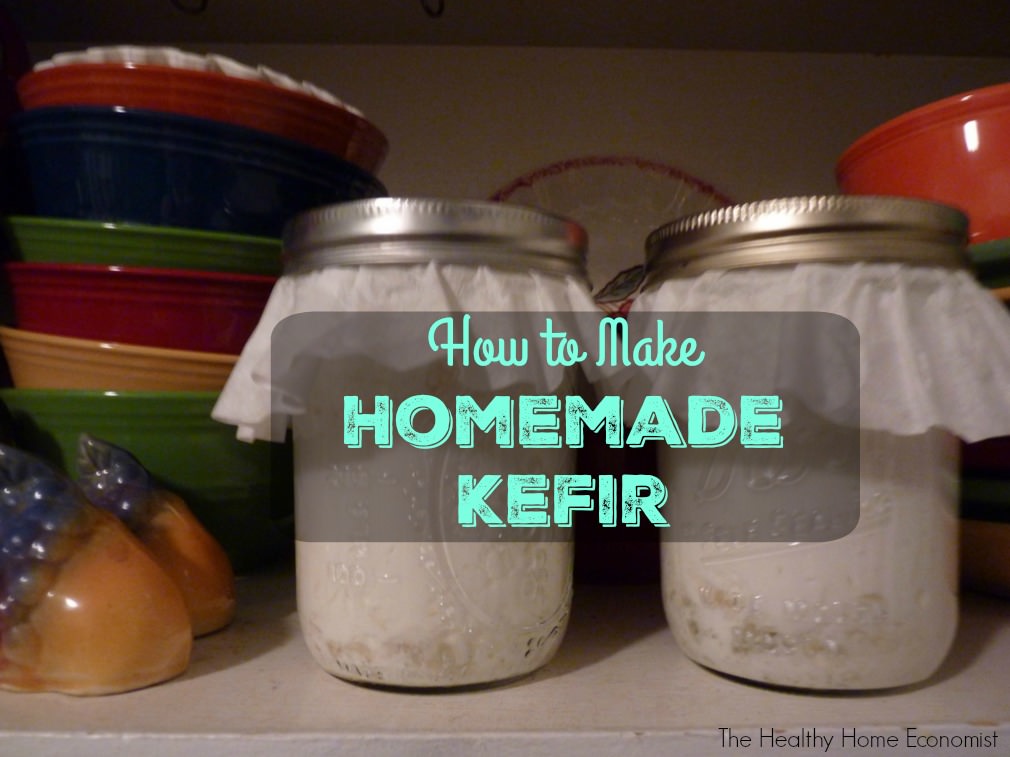Table of Contents[Hide][Show]
How to make homemade kefir the traditional way by fermenting on the counter for 24 hours with farm fresh milk.

I prefer homemade kefir to yogurt because yogurt only has 2-5 strains of beneficial bacteria None of these aggressively attack and destroy pathogens in the gut like the probiotics in kefir do.
By the way, kefir is pronounced ku-feer (not kee-fer or ke-fer).
Kefir made at home has dozens of beneficial bacterial strains as well as several beneficial yeasts. Kefir compared to yogurt is no competition. Kefir is much more beneficial for gut healing.
The one catch is that you need to learn how to make kefir yourself!
Commercial kefir brands typically have far less microbial strains and are not fermented long enough to have the same benefits.
Homemade Kefir Benefits
In a gut that is dominated by pathogens and candida overgrowth (as in someone who has taken many rounds of antibiotics and other prescription drugs over the years and/or eats primarily processed foods), yogurt tends to have only a temporary beneficial impact.
As mentioned earlier, homemade kefir has about 30 beneficial strains of bacteria and yeasts that do aggressively recolonize the gut by destroying pathogens.
As a result, kefir has the potential to permanently alter the gut environment for the better whereas yogurt does not.
The best way to make homemade kefir is to obtain live kefir grains from a friend. They grow slowly over time and extras can be given away (or even eaten as a live probiotic).
Avoid using powdered starter for kefir. It has little to no therapeutic value.
If you cannot find any live grains in your community, you can mail order them.
Other Types of Kefir Made at Home
If learning how to make other types of kefir interests you, check out this video on how to make water kefir.
This video plus recipe on how to make coconut milk kefir is helpful if you wish to make a dairy-free version of the milk-based kefir below.

Homemade Kefir Recipe
Easy recipe for homemade kefir fermented on the counter for 24 hours to maximize beneficial microbial strains for gut healing.
Ingredients
- 1 quart raw milk preferably grass-fed
- 1 wide-mouthed mason jar
- live kefir grains
Instructions
-
Pour the raw milk into a clean glass mason jar leaving about 1 inch at the top. You can use cold milk right out of the refrigerator if this is more convenient. Gently stir in live kefir grains. Roughly one-quarter cup of grains is sufficient to ferment the entire quart.
-
Screw on the lid and leave on the counter at room temperature for 24 hours. Over this time, you will see the milk slightly separate and thicken.
-
The kefir should be ready after 24 hours of fermentation time. If powder culture was used, you can use the kefir as is. If live kefir grains were used, gently strain them out to use again with the next batch of raw kefir.
Recipe Video
Recipe Notes
You do not need to rinse live kefir grains before using again. Rinsing them slightly weakens them in my experience.
Homemade kefir will last many weeks in the refrigerator, but its flavor will get stronger over time.








Greetings from London!!
Sarah, would like to ask if you strain the kefir ones it is ready? you did not mention this on your video and I have seen many other videos and always see the people using a strainer. If you don’t could you please elaborate whether its better to or not to strain??
many thanks and best regards
I just tried activating my kefir grains from Cultures of Health. After the third day it all just looks like about a quarter of a cup of cottage cheese….there isn’t anything at all that resembles a cauliflower.
Is this still usable? I changed the raw milk 3 times so far to activate it so I haven’t made kefir yet.
It takes time for your cultures to mature… Use less milk at first
Hi Sarah,
I just bought my kefir grains. I’ve been told that once they start to grow, we can eat the extra grains, and give them to my kid (they taste like sour gummy bears). My son is 18 months; how much would be too much? I know is healthy… but is there a risk in over do it? Thank you for you lovely posts and videos, you really did change our lives.
My kefir grains float to top of the jar and get coated with the cream. The kefir then doesn’t seem to ferment as well. I’d love to keep the cream in the kefir, but the skim milk kefir seems to ferment better. Any thoughts or ideas?
Victoria, I’m not Sarah, but perhaps I can help a little. I imagine it would take quite a long time for grains to grow to the size that Sarah shows in this video. I bought my grains from CFH last year (August, I think) and at that time I had 4-5 about the size of BBs…this was when they were in their dehydrated state. After about 4-5 days of rehydration, they started making consumable kefir, but after all these months, I have 7 grains of varying size, everything from one that is BB size still (I thik it broke off from a larger grain) to 4 that are almost the size of a small marble. I currently split the 7 grains into 2 separate quart jars, and both make lovely kefir. I wouldn’t expect your grains to look like the size of the ones in the video for quite some time. They take some time to grow. Just today I got the bright idea of taking my two smallest grains and putting them in their own quart jar to ferment, with the hopes they might grow a bit so they’re easier to find when I’m straining. Now I have 3 quarts going at a time! Luckily, this family of 5 goes through lots of kefir. Hope this is somewhat helpful!
I have been trying to rehydrate my kefir grains that I purchased from Cultures for Health, but I don’t know that I am achieving it. I think I am following the directions, and I have been doing the 1 cup of milk each day for 6 days, and it coagulates but mine never gets to look like cauliflower. It is still in grains, I think. I stir it and strain it as instructed but it strains down to little bits of material and I wash and dry the original container, put the strained grains in it and add new milk. It smells fine, like yogurt to me, but the consistency is never like yours, a hunk like cauliflower. The temperature is right at 70, so maybe I will move it to a warmer place in the house, and keep trying. The instructions said 4-7 days, but it says under some circumstances it may take 2-4 week to start making kefir. I’ll keep trying in a little warmer place.
Is milk kefir ok for someone with casein intolerances/allergies? I know the lactose is eliminated (which is great), but is the casein denatured that so I can tolerate it?
Is goats milk easier to handle than cows?
And is the goat milk from whole foods ok to use?
Thanks!
Sarah, I love this site, videos and your book. I made my first batch of Kefir but I don’t know what it is supposed to taste like. It was REALLY sour (and I typically like sour things). I even tried to blend it with blueberries to get it down. Can anyone describe the taste so I know if I did it right?
Hi Sarah,
Thanks for the great video on kefir. I have two questions for you…
Firstly, you mention that kefir has 30 beneficial strains of bacteria, is that a fact backed up scientific research? Could you please provide the reference if you have it.
Secondly, When I make kefir usually the whey(liquid watery stuff) is at the very bottom and the more solid white stuff is at the top. I mix it all evenly with a wooden spoon before I strain it with a plastic sieve. After straining I collect the grains from the sieve but I don’t see them in ball like formation as a cauliflower in the jar. In the jar it seems like they are spread out evenly in the thick layer of yogurt at the top. Am I doing it right and is it ok to use plastic sieve?
Thanks,
Shekhar
Caroline, make a smoothie with it! puree some blueberries, or strawberries. Fresh cherries are the BEST! I like to add a little honey too.
Sarah, I read somewhere (I don’t remember where) that high speed blending can damage the kefir. Is this true? Should I puree the fruit seperately and then mix in the kefir by hand?
Thanks!